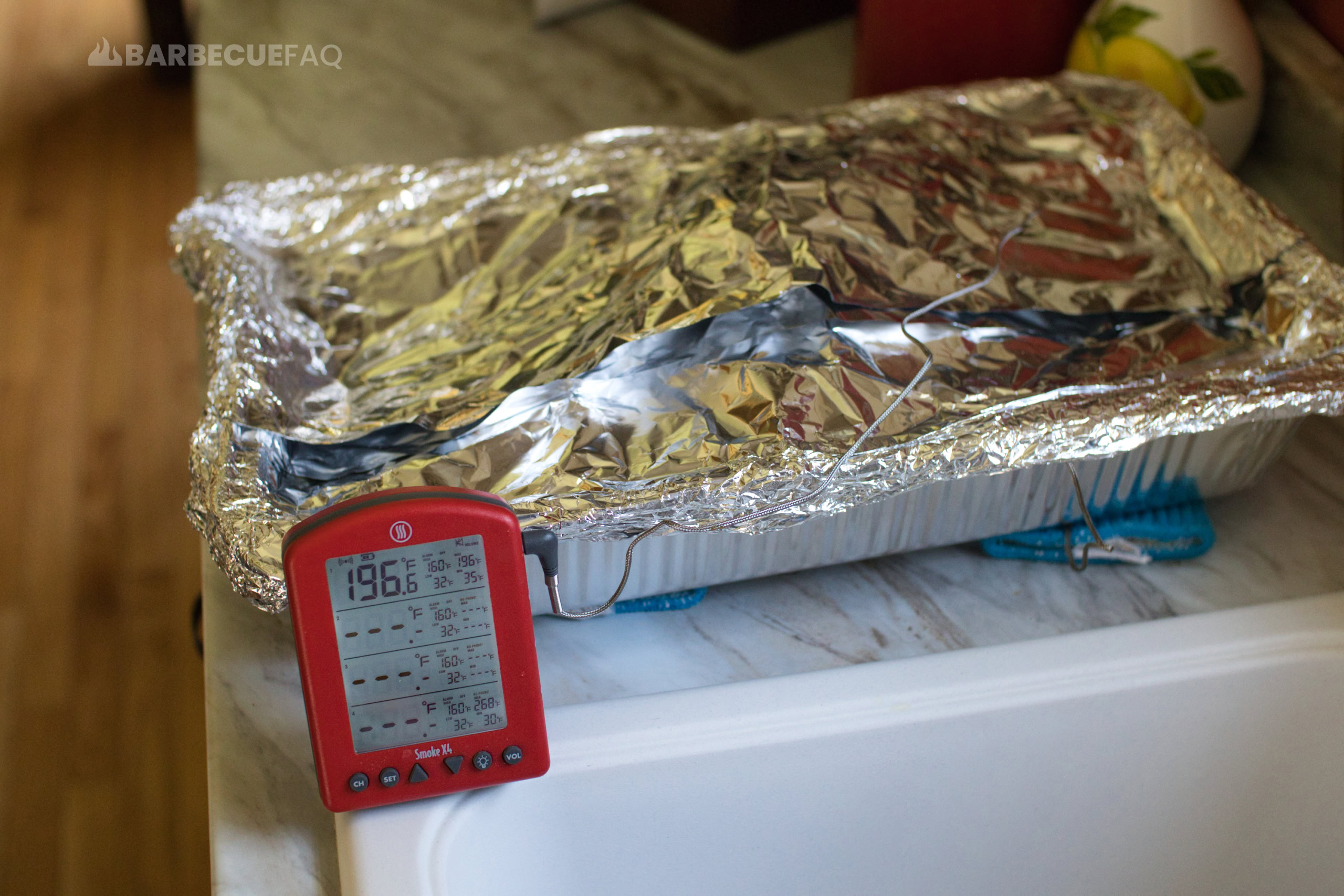Why ~2 Hours for Resting Pork Butt?
The reason people repeat this number is because that’s how long it takes to go from 190-205F down to 150-160F.
Just to prove this, I took pictures of my pork butt for this article and noted the timestamps of the photos.
I took my pork butt to probe tenderness – for me this happened at 195F.

I then took my foil pan off my smoker and brought it inside.
In this timeframe, carry over cooking occurred and the peak temperature the pork butt reached was 196.6F.

I then rested the pork butt down to 160.1F:

This took 1 hour and 26 minutes.
This timeframe is about average and what I’ve seen across hundreds of pork butt cooks.
If you were resting in a cooler or “faux cambro” you’re bringing the temperature down much slower (on purpose) and this typically takes 4-6 hours, depending on your cooler.
Why is Pork Butt Rested?
There are 2 primary reasons for allowing this to happen:
- Finishing temperatures like 190F+ are too hot to handle and aren’t safe eating temperatures (as you could burn/scald yourself).
- You need to give the melted collagen (the muscle fibers of the meat) time to gelatinize.
The main point to discuss is the gelatinization of the collagen:
As most people know, a pork butt is a tough cut of meat and in order to break down and render the connective tissue (primarily collagen), you need to cook the meat low and slow (~225F to 275F) for an extended period of time.

If you were to do the opposite – i.e. sear hot and fast, the temperature may certainly reach 190 – 205F+ but the pork butt won’t be tender.
Meaning, the rendering of collagen/connective tissue is a function of both:
- time,
- temperature
Suffice to say, we then need to keep pork butt in the internal temperature range of 160 – 205F for several hours to melt the collagen into a gelatin.

Gelatin is hydroscopic and will absorb up to ten times its weight in liquid and muscle tissue is primarily comprised of water.
At elevated temperatures of around 190F+, this gelatin is somewhat liquefied. As it cools or is “rested” it begins to solidify or “gelatinize.”
Equate this to Jell-o (which is made by heating gelatin in water).
When you heat Jell-o, it liquifies; When you chill it, it gelatinizes.
If you were to pull the pork after the meat reached tenderness, the juices that comprise the pork butt wouldn’t have enough time to set back up or gelatinize, and they’d run out of the pork.
The result? Dry pulled pork.
Food Safety and Resting
An important fact to keep in mind is food safety. The food safety danger zone is between 40 – 140F; At these temperatures bacteria multiply quite rapidly.
Meaning, when resting, you don’t want to go below 140F.
To avoid this, People will rest to around 150-160F internal and then pull the meat.
Holding Pork Butt aka “Extended Rest” – The Secret to Good Barbecue
A concept that you’ll hear people bring up in barbecue is that the best kept secret is an extended “hold” or “rest.”
However, if you really think about it – it’s not much of a secret.

When a Barbecue Restaurant smokes large cuts of meat, it’s borderline a requirement that they’re smoked a day in advance. That way they’re ready for service in the morning at 11 am when they open.
I mean it’s pretty unrealistic to think they’re working 3rd shift to smoke pulled pork.
Rather, they’re smoking to tenderness or near tenderness and then they’re holding overnight.
In a restaurant setting, this is achieved with specialized warming cabinets that are calibrated to specific temperatures and even humidity; Common brands include Alto Shaam and Cres Cor.
It’s Possible to Hot Hold at Home too
Almost all my pork butts these days are smoked on my Weber kettle.
When they’re out of the stall (170F+), I like to wrap them in an aluminum pan and then put them in my electric smoker until they reach probe tenderness.

When holding pork butt, there are really 2 options:
- Smoke to tenderness, then rest for 1-2 hours, then put back in your electric smoker or oven set to 175F* overnight.
- Smoke to near probe tenderness (190F), then drop the temperature of your smoker to 175F, and leave the pork butt wrapped without a rest.
*This number is based on testing. You need to test you device at home before doing this.
If your goal is to hold pork butt for an extended period of time – like the next day – I find the second method results in better pulled pork.
Where-as the first method is better used when you’re pulling the pork the same day i.e. smoke to tenderness, rest for 1-2 hours, then pull.
In the first scenario you’re also resting where-as in the second scenario you’re allowing the meat to carry over cook through hot holding.
Note: Always hold the muscle whole.
If you were to do the first method and then pull the muscle after resting, it would result in dry pulled pork simply due to oxidation. By holding the muscle whole, you minimize oxygen interaction.
Do You Need to Rest After Hot Holding?
No.
Technically what you just did was an extended rest.
You’re taking your meat from tenderness or near tenderness and then you’re resting for 12+ hours and maintaining 145F+ internal.
After you take the meat out of the holding oven, you can pull the pork butt.




